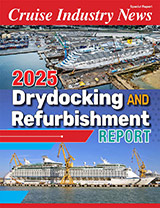The European cruise industry continues to increase its share of the global cruise market despite facing an unprecedented period of difficulty for the world economy. Figures, released today by the European Cruise Council (ECC) at their annual conference in Brussels, show that passengers made 23.8 million visits to European ports in 2009, an increase of more than 9% over 2008, with 4.9 million European residents booking a cruise holiday last year, a rise of 50% in five years, and representing nearly 30% of the world’s cruise passengers.
The European cruise industry now generates more than €34 billion of goods and services with the figures showing the growing importance to Europe of cruising in terms of wealth, tourism and providing nearly 300,000 jobs. More than 4.8 million passengers joined their cruise in Europe and spent €1.3 billion on services including airfares, accommodation, tours, food and port fees, an increase of 7.6% on 2008. Passengers also spent €1.45 billion while visiting ports during their cruise holiday, 1.7% up on 2008.
Manfredi Lefebvre d’Ovidio, chairman of the ECC and deputy chairman of Silversea Cruises, said: “2009 was an unprecedented year with all holiday sectors being affected by the economic downturn. Therefore it’s particularly rewarding that these latest figures show the resilience of the European cruise industry which is outperforming other holiday sectors.”
Mr Lefebvre continued: “The total value of goods and services generated in 2009 has reached €34.1 billion, a rise of nearly 6% over the previous year. The industry has also increased the amount it spends on services, supplies and equipment to €5.4 billion, growth of 86% over the last five years. However, we have not been immune to the recession and have seen a slight reduction in direct expenditure – down just over one per cent to €14.05 billion which was as a result of a downturn in ship building. Although at least 29 ships are being built in Europe between 2010 and 2014, new orders have slowed. European yards need encouragement to enable them to be as competitive as possible and to stimulate further new orders. There’s huge potential for further growth provided new ships continue to be built.”
ECC Vice Chairman and Chief Executive Officer of MSC Cruises Pierfrancesco Vago added: “The figures released today clearly demonstrate that the European cruising industry is a resilient business which can deliver valuable economic output. The core reason for this success is the appeal of a cruise holiday – it offers such an incredible array of choices for all ages, from luxury to budget, while consistently providing high standards and exceptional value for money.”
The ECC commissioned the 2009 economic impact report together with Euroyards. Key results include:
• 23.8 million passengers visited a European port, an 80% increase since 2005
• 4.8 million passengers joined their cruise at a European port
• 152 cruise ships were operating in the Mediterranean and 95 in Northern Europe
• The European cruise industry generated 296,288 jobs in 2009
• Italy is Europe’s largest centre for cruise ship construction with more than half of new builds through until 2014
• The UK provides the largest number of cruise passengers within Europe
• Greece and Italy continue to compete in popularity as destinations, with both holding nearly 21% of the market; Spain retained its third position with 17.3%
• Capacity projections suggests about 5.4% growth in passenger numbers cruising Europe in 2010
• Calls projected to increase by about 3.1%



